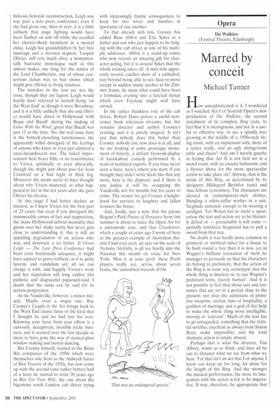Marred by conceit
Michael Tanner
How unsophisticated is it, I wondered as I watched Act I of Scottish Opera's new production of Die Walkiire, the second instalment of its complete Ring cycle, to feel that it is incongruous, and not in a useful or effective way, to see a spindly tree growing in the middle of a 1950s-style living room, with an unpleasant sofa, more of a settee really, and an ugly dining-room table and chairs? And am I merely gauche in feeling that Act II is not best set in a motel room, with an ensuite bathroom, and a flyover above for the more spectacular action to take place on? Anyway, that is the mode of this Ring, as determined by its designers Hildegard Bechtler (sets) and Ana Jebens (costumes). The characters are dressed in contemporary-style clothes, Hunding a white-collar worker in a suit, Sieglinde untrendy enough to be wearing a cardigan. Yet Wotan has to wield a spear, unless the text and action are to be blatantly defied or — presumably it will come — partially rewritten; Siegmund has to pull a sword from that tree.
No doubt it was hardly more common in primeval or mythical times for a house to be built round a tree than it is now, yet in Wagner's brilliant recreation of myth he manages to persuade us that his characters do belong to prehistory, that the action of the Ring is in some way archetypal, that the whole thing is timeless or, to use Wagner's preferred term, 'purely human'. And it is not possible to feel that about sets and costumes that are set in a period close to the present; nor does the admixture of primitive weapons, archaic laws of hospitality, a goddess of marriage and a god of fire help to make the whole thing more intelligible, moving or 'relevant'. Much of the text has to go unregarded, something that the faithful surtitles, excellent as always from Simon Rees, make impossible; and the total dramatic action is simply absurd.
Perhaps that is what the director, Tim Albery, wants us to think, and does all he can to distance what we see from what we hear. Yet that isn't an act that I or anyone I know can keep up for long, let alone for the length of the Ring. And the stronger the musical performance, the more its integration with the action is felt to be imperative. It may, therefore, be appropriate that
the musical side of things in Die Walkiire is only moderate to good. Richard Armstrong's conducting is the single biggest cause for satisfaction, or rather the sounds he elicits from the enlarged orchestra. The playing, especially the many solo woodwind passages, was often ravishing; and the variety of kinds of sound that Armstrong drew from the lower strings put me in mind of Goodall, Armstrong's mentor and equally a specialist in minute particulars. He, though, had famously a nearly unique grip on the whole structure, while Armstrong's fluctuates. Certainly he has advanced hugely from his Welsh Ring, but in Act I he built up the tension satisfactorily to the point where Hunding goes off to his drugged sleep, but then, as Wagner opens the lyrical floodgates at last, Armstrong was too besotted to get a move on: the second half of Act I is a sublime blend of urgency and sumptuousness, but we only got the latter. Ursula Ffiri-Bernhard's Sieglinde had plenty of time to do up the laces of her sensible shoes for the second time as Siegmund pulled the sword from the tree. The Volsung twins are a strong pair, the Siegmund of Jan Kyhle a powerful presence, with a tight, plaintive but strong voice which is most suitable for the part. Fad-Bernhard lacks warmth in her lower register, but has temperament, and made a strong impression in her short Act III scene.
Act II, despite its depressing setting, was mainly a success, though the biggest single disappointment of the performance is Matthew Best's Wotan. It has retreated from the distinction of last year's Rheingold, and seemed to be, after midpoint in Act II, largely a struggle for vocal survival, a struggle which he lost on the very last note of the work. His tone is grey and withdrawn, which suits the Walkiire Wotan well so long as it is varied in dynamics and colour. At present this is just a sketch of Wagner's most astonishing piece of characterisation to that point in his development as a dramatist. The Bilinnhilde, the last-fortnight replacement Elizabeth Byrne, is still settling into her role too, but she gave more positive satisfaction, though both of them lacked sheer volume for their final efforts. Given the difficulties of fitting into a production, she was remarkably assured, and the very slowpaced 'Annunciation of Death' in Act II showed both her and Kyhle at their finest. The grave nobility of many stretches in this act received its full, overwhelming due.
The Valkyries are ladettes, raiding the fridge for lager, belching and having to be held under cold taps. Granted that it's a hard scene to stage, this is not a possible solution. Nor was I impressed by Briinnhilde putting herself to sleep and arranging her armour thoughtfully, while Wotan kept his distance. Least of all did I welcome the appearance of Loge the character, in his red coat, camping around, and after inducing jets of flame round Briinnhilde's diminutive rock settling himself, cross legged, on a small column. What a producer's conceit? This functionless indulgence in what might strike someone for a moment as a bright idea at present undermines what could still be one of the best old-fashioned 'new' Rings around.




































































 Previous page
Previous page